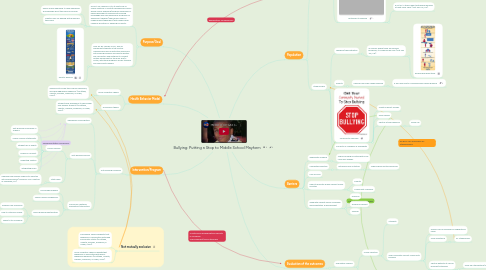
1. Population
1.1. Adolescent Boys
1.1.1. Bullies
1.1.1.1. Characteristics of bullying
1.1.1.1.1. Power Imbalance
1.1.1.1.2. Negative & Intentional
1.1.1.1.3. Repetitive
1.1.2. Victims
1.1.2.1. Middle School Boys
1.1.3. Witnesses to Bullying
1.1.3.1. 6 out of 10 teens report witnessing bullying at least once a day (Just Say Yes, n.d.).
1.2. StakeHolders
1.2.1. Teachers/Administration
1.2.1.1. In schools where there are bullying programs, it is reduced by 50% (Just Say Yes, n.d.).
1.2.1.1.1. Responding Effectively
1.2.2. Parents
1.2.2.1. Helping Your Kids Handle Bullying
1.2.2.1.1. 5 Do’s and Don’ts of Helping Kids Handle Bullying
1.2.3. Community Members
1.2.3.1. Create Support Groups
1.2.3.2. Fund Raising
1.2.3.3. Identify at risk behaviors
1.2.3.3.1. Speak Up
1.2.4. Conflicts in Schedules & Availability
2. Purpose/Goal
2.1. Goal #1: By January 2019, at least 50% of school systems in Central Nebraska will have a whole school approach/program developed or being developed to provide anti-bullying knowledge and raise awareness programs for adolescent children (specifically males in middleschool/highschool) with funds being raised by donation or applying for grants.
2.1.1. Whole school approach to raise awareness & knowledge about the issue of bullying
2.1.2. Create a plan for dealing with bullying in the school
2.2. Goal #2: By January 2020, 50% of adolescent students in the Central Nebraska area will be activitely involved in anti-bullying program and able to identify any risk factors and methods to combat further harassment as the bully and/or victim, with these programs led by teachers and community leaders.
2.2.1. What is Bullying
3. Health Behavior Model
3.1. Social Cognitive Theory
3.1.1. Adolescents model their friends' behaviors, including aggressive behaviors (Mouttapa, Valente, Gallaher, Rohrbach, & Unger, 2004).
3.2. Dominance theory
3.2.1. Students use dominance to gain power over weaker students (Mouttapa, Valente, Gallaher, Rohrbach, & Unger, 2004).
4. Barriers
4.1. Inadequate Funding
4.1.1. School funding is limited with Core cirriculum already
4.2. Competing Priorities
4.2.1. Extracurricular Activities
4.2.1.1. Schools have limited resources
4.3. Lack of Time
4.4. Need to educate & gain support of key nonstaff
4.4.1. Parents
4.4.2. Community Members
4.5. Adequate support policy & program implementation & development
4.5.1. Finances
4.5.2. Technical Support
4.5.3. Training
5. Intervention/Program
5.1. Anti-Bullying Programs
5.1.1. Awareness & Recognition
5.1.2. Anti-Bullying Policies
5.1.2.1. School Policies
5.1.2.1.1. Anti-Bullying Procedures in Schools
5.1.2.1.2. School Mission Statements
5.1.2.1.3. Student Bill of Rights
5.1.2.1.4. Codes of Conduct
5.1.2.1.5. Reporting System
5.1.2.1.6. Integrating Rules
5.1.2.2. State Laws
5.1.2.2.1. Nebraska law requires schools to adopt an anti-bullying policy (American Civil Liberties of Nebraska, n.d.).
5.1.3. Cirriculum Centered Prevention/Intervention
5.1.3.1. Encourage kindness
5.1.3.2. Teach Coping Mechanisms
5.1.3.3. Teach Bullying Identification
5.1.3.3.1. Address Peer Pressures
5.1.3.3.2. How to Intervene Safely
5.1.3.3.3. When to tell Someone
6. Evaluation of the outcomes
6.1. Population Specific
6.1.1. Nurse Sensitive
6.1.1.1. Students
6.1.1.2. APRN evaluates current community program
6.1.1.2.1. Policies can be improved or suggestions made
6.1.1.2.2. Offer assistance
6.1.1.2.3. Identify patients at risk for bullying/victimizing
6.1.2. Program Specific
6.1.2.1. Cost
6.1.2.1.1. Cost can be offset by fundraising
6.1.2.2. Implementation Results
6.1.2.2.1. Many school-based interventions directly reduce bullying, with better results for interventions that involve multiple disciplines (Vreeman, & Carroll, 2007).

